India Indian music music vocalists: 78 rpm discs Marwari geet
by Warren
3 comments
Meta
SiteMeter
Brighter Planet
78 rpm Records of Indian Music: Parvati and Party of Udaipur
More Marwari geets in the vivid low fidelity that appears characteristic of the output of “Marwari Records.” Parvati and Party get a nice groove going, and it is enjoyable to listen through the distortion to get a picture of what this music originally sounded like.
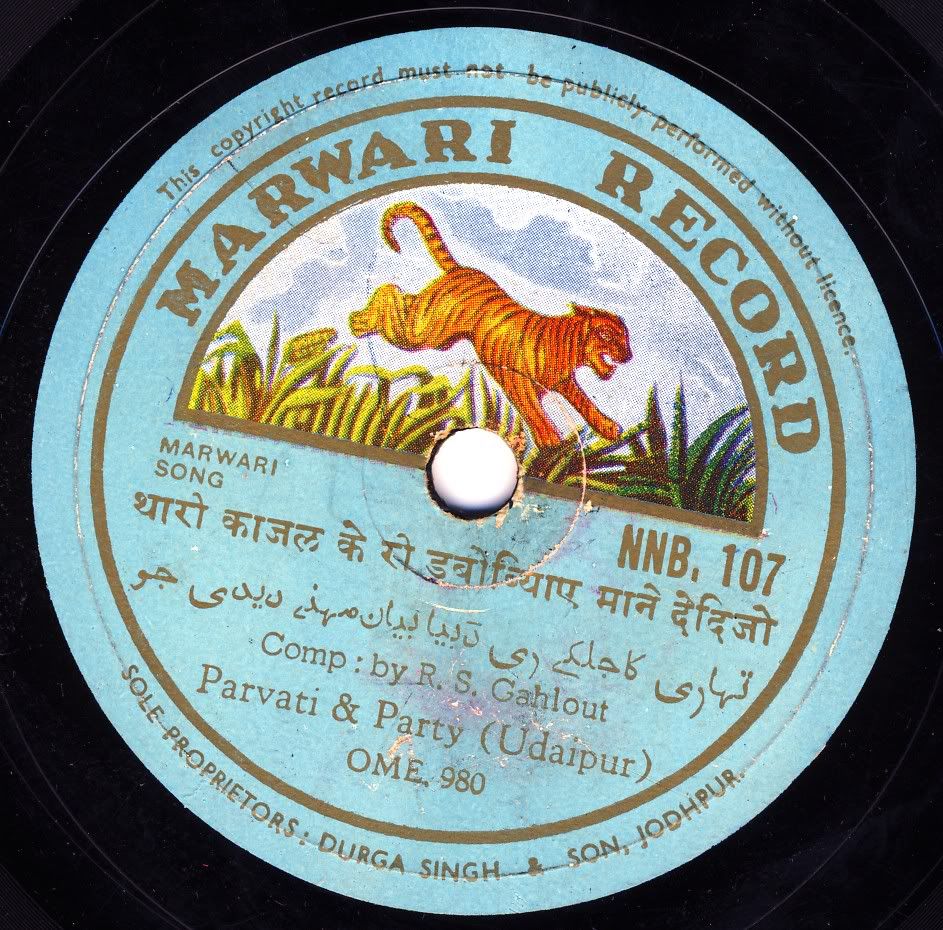
Lo-fi they may have been, but you’ve got to admit that Marwari Records had a damn cool label. I love the tiger, don’t you?
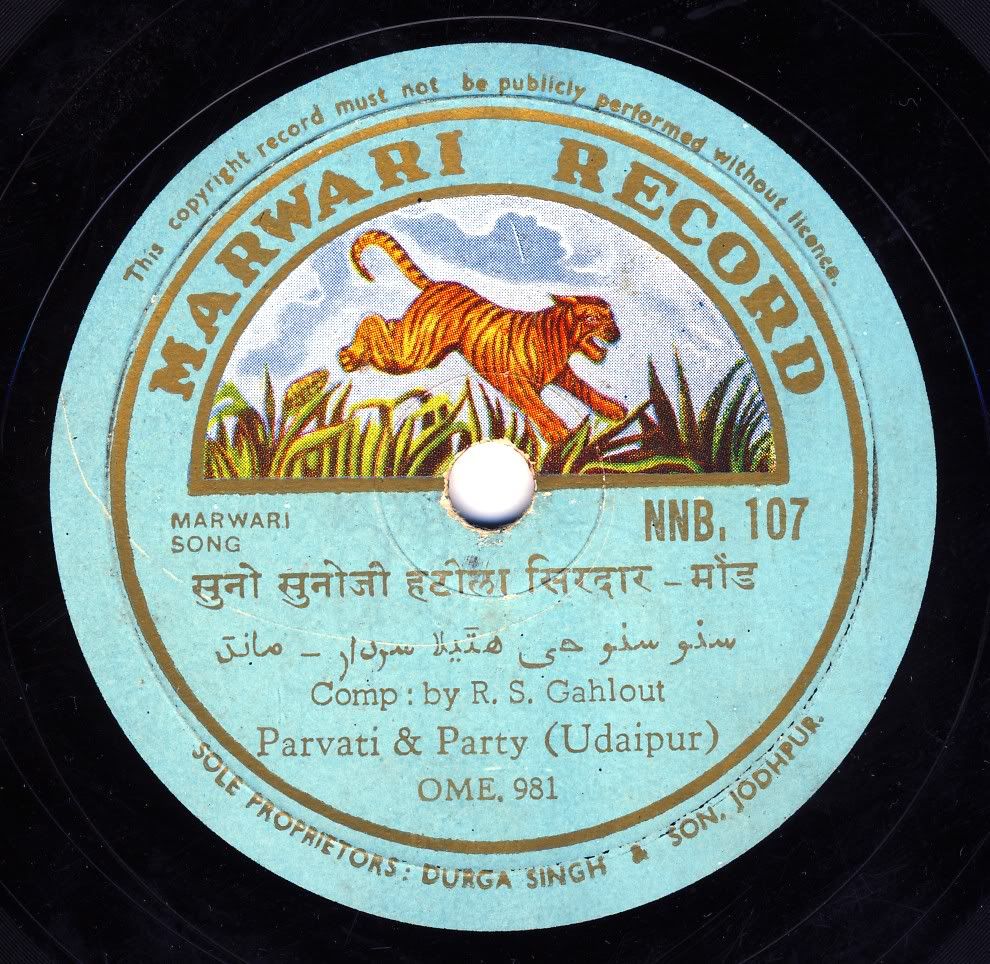
Listening to these 78 rpm discs is a wonderful experience. It’s like falling in love.
India Indian music music vocalists: 78 rpm discs Indian folk music Marwari geet
by Warren
1 comment
Meta
SiteMeter
Brighter Planet
78 rpm Records of Indian Music: Dhirasen of Jodhpur
My wife and I were in Udaipur in 2000, and we discovered a tiny little out-of-the-way junk shop that just happened to have a big stack of old 78 rpm discs for sale. I picked up as much as I could carry. None of the names were ones I recognized; these were all regional songs in Rajasthani, Marwari and Urdu.
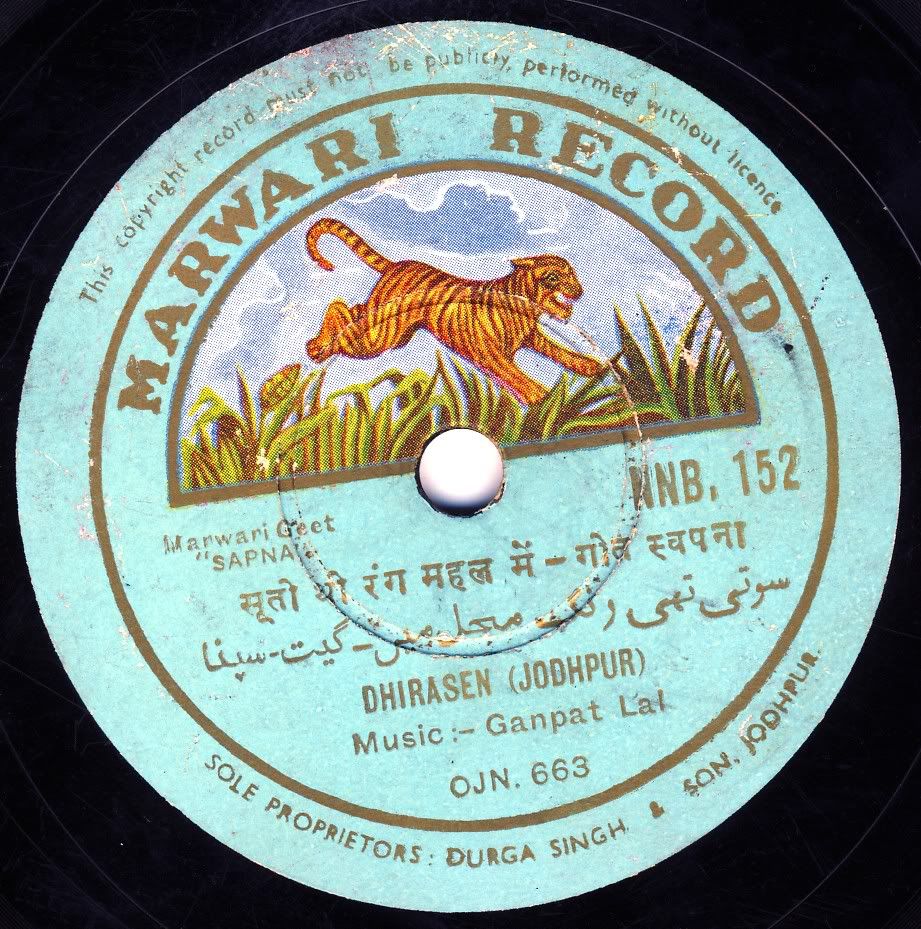
Here are two Marwari songs by a lady about whom I know nothing, Dhirasen of Jodhpur. The distorted sound is on the disc; Marwari Records was obviously not a top-of-the-line operation.
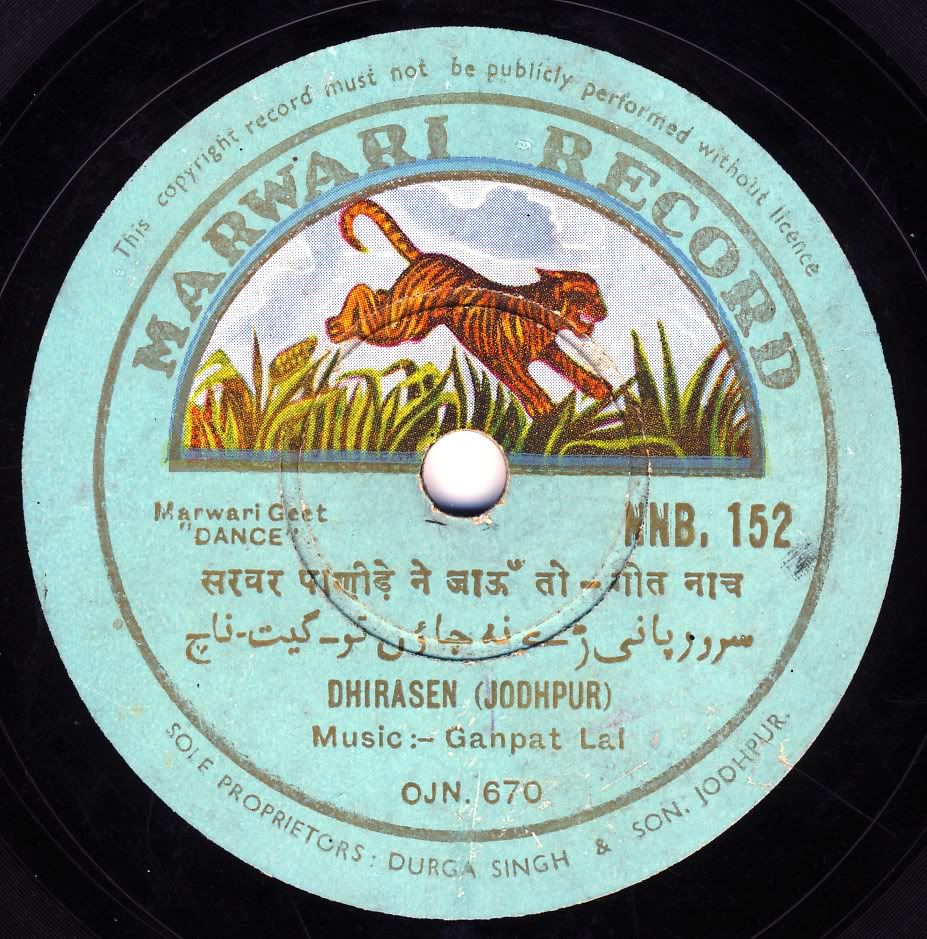
I find these recordings mysteriously evocative.
India Indian music music vocalists: near genius thumri
by Warren
4 comments
Meta
SiteMeter
Brighter Planet
78 rpm Records of Indian Music: Bai Sundra Bai
Bai Sundra Bai was one of the most heavily recorded artists from the thumri culture of the early 20th century along with Gauhar Jan, Janki Bai and others. Originally from Pune, her repertoire included Marathi bhavgeets along with thumris, ghazals and occasional khyal performances. Her recording career extended into the late 1940s, with some work for films.
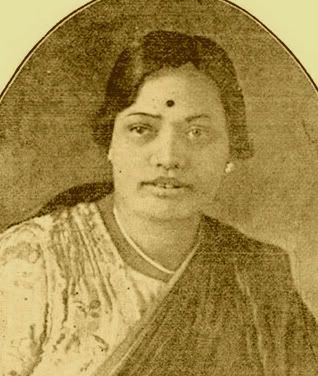
I enjoy these two thumri performances, both on fairly standard Krishna texts. Both show her flexible voice and excellent taan technique; the Tilak Kamod in particular is very impressive.
Tilak Kamod: “Avata hai giridhari”
Jhinjhoti: “Kanha charavata gaayi”
India Indian music music vocalists: geet tappa thumri
by Warren
3 comments
Meta
SiteMeter
Brighter Planet
78 rpm Records of Indian Music: Miss Indubala
For a self-described “amateur,” Miss Indubala recorded very prolifically, as this discography shows. Of course, the word “amateur” was code for “Do Not Mistake Me For A Tawaif.”
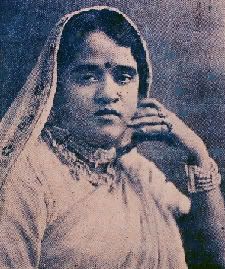
Miss Indubala: 1899-1984.
This is an unusual piece. The opening mukhda and much of the following singing uses frequent tappa-ang taankari, but the text is Hindi, and describes Lord Shiva — playing the games of Holi!
I have never heard any other Hori composition which includes Shiva in the festivities.
The other side of the record, unfortunately, has so many skips and pops in it that trying to piece together the performance is beyond me at the moment.
Indubala’s life story would make a good movie:
Indubala’s mother was Rajabala, who along with sister Matibala and brother Tinkary worked in Motilal Bose’s The Great Bengal Circus, also known as Bose’s Circus or Professor Bose’s Circus. Harimati was the eldest sister of Rajabala and had a different life. Rajabala performed mainly as a trapeze artiste and got married to Motilal Bose at a temple in Ujjain, India. At the time he was then in his forties while Rajabala was still a teenager. The marriage was never accepted as legal by Motilal’s family. Motilal Bose’s first wife was Mrs. Annadamohini Devi. Indubala was born in Novenber, 1899 at Amritsar, where the circus party had gone for performance. Indu was born premature and Dr. Bidhumukhi Basu was taken to Amritsar from Calcutta to attend to Rajabala. Such was the affection and concern of the husband for his young wife. Motilal’s interest in Rajabala dwindled later, supposedly because Rajabala showed no interest in going back to the circus after Indu’s birth and soon she was left to fend for herself. She came to Calcutta with her daughter and was given shelter by a Jiban Krishna Ghosh, who remained loyal to her till his death and also played a major role in establishing Indubala in her life as a performer. Once in Calcutta, Rajabala trained herself as a singer and Indubala’s first training in music was from her mother. The initial plan was to train Indu as a nurse and she was admitted as a trainee in a hospital in the Pataldanga locality of Calcutta. Indu did not take fancy in the job and ran away from the hospital, much to the disappointment of her mother, who never wanted her only daughter to be forced into a life of indignity. After this incident Indubala’s musical training started. Although her father ignored wife Rajabala completely, he remained fond of his daughter and kept in touch with her and often invited her to his ancestral home where he lived during his brief visits to Calcutta and sent her a monthly pocket money of Rupees twenty till his death. Indubala’s first performance was at a gathering of distinguished guests where her mother was the chief entertainer. Each one of the guests appreciated Indu’s singing and thus began her formal training from Gouri Shankar Mishraji. Indu was only about twelve then. This also marked the entry of Indubala into the red light world. Amongst her trainers were Kali Prasad Mishra, Elaahi Bux and Miss Gauhar Jaan. Apart from music, Miss Gauhar Jaan, credited as Prima Donna of India, Indu also learned etiquette from the elder artiste and developed a close friendship with her. This association provided Indu with valuable musical knowledge and experience.
India Indian music music vocalists: Marathi bhavgeet near genius
by Warren
leave a comment
Meta
SiteMeter
Brighter Planet
78 rpm Records of Indian Music: G.N. Joshi
G.N. Joshi was both a singer and the main A&R man for HMV India; “Down Melody Lane,” his reminiscences of a life in music, is an excellent read.
Here are two of the Marathi geets he recorded at the beginning of his career.
His voice production is easy and clear, and he handles the melismatic passages with aplomb.
The next item is based on the popular afternoon raga Patdeep, and includes some lovely improvisation; it is a khyal performance in all but name. Joshi’s melodic imagination is captivating; the piece ends with some excellent taankari.
Indian music music vocalists: 78 rpm discs geet ghazal thumri
by Warren
1 comment
Meta
SiteMeter
Brighter Planet
78 rpm Records of Indian Music: Ali Hussain Quawal
Here are two songs by an artist about whom almost no information is available. The record label simply states “Ali Hussain Quawal (Blind Singer).”
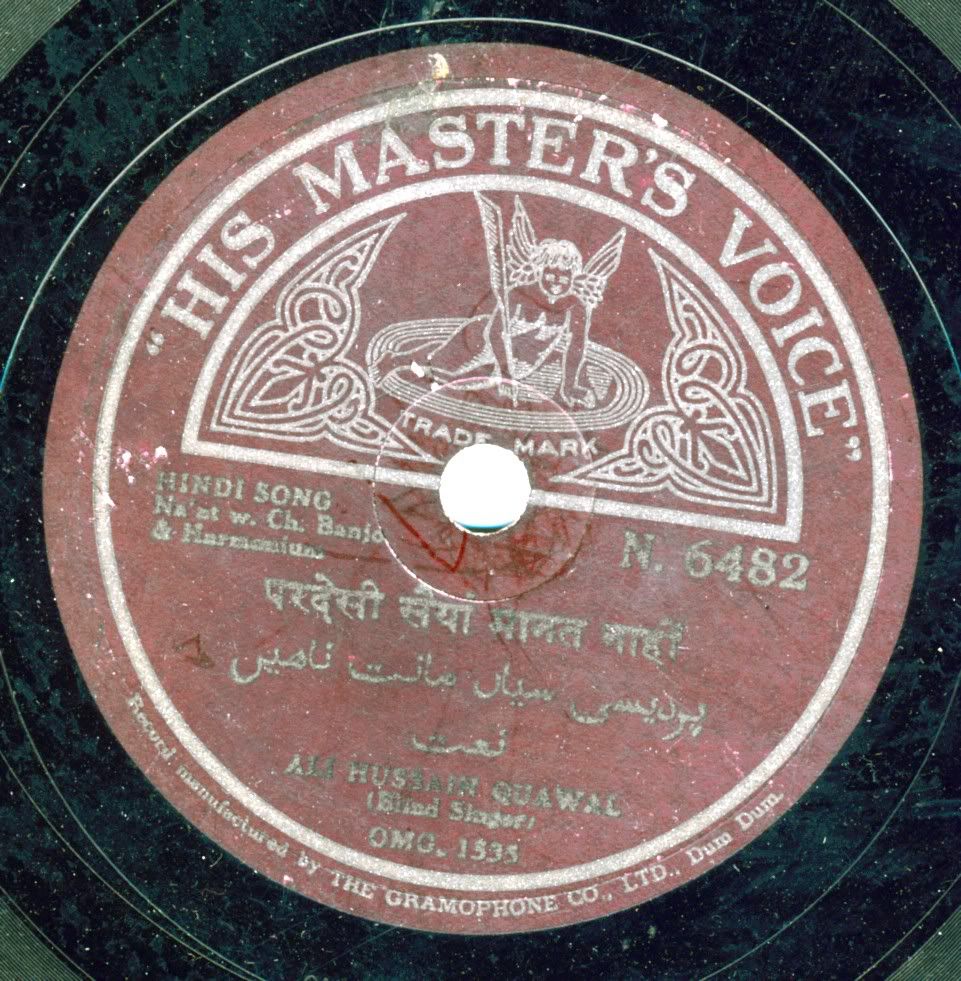
The short instrumental interludes between stanzas are fascinating.
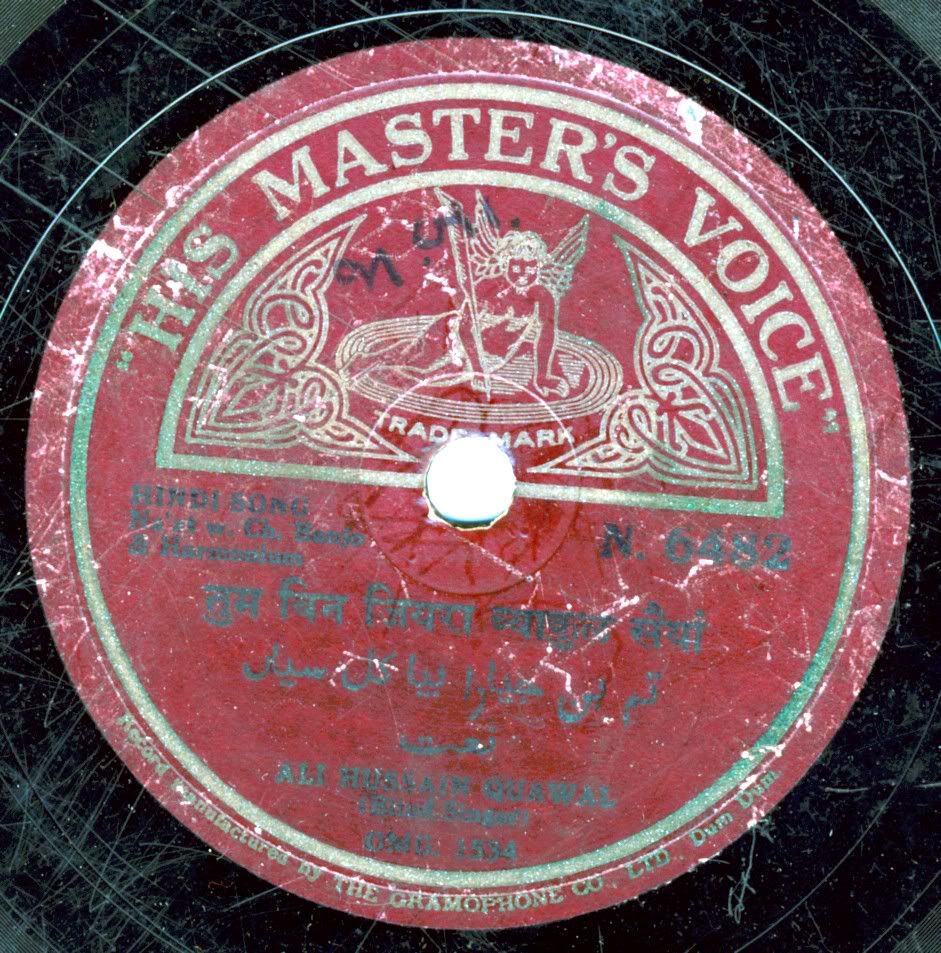
==========================================
“Tum bina jiyara vyakul saiyan”
==========================================
“Pardesi saiyan manata nahin”
India Indian music music vocalists: genius khyal
by Warren
3 comments
Meta
SiteMeter
Brighter Planet
More Early Mallikarjun Mansur To Delight Your Ears
Three more gems from Buwa’s Gwalior period, for your enjoyment:
“Karnataka Kafi”
==========================================
Raga Puriya
==========================================
Raga Brindabani Sarang
Indian music music vocalists: genius khyal
by Warren
3 comments
Meta
SiteMeter
Brighter Planet
Faiyaaz Khan: Aftaab-e-Mausiqi
Raga Darbari Kanada
==========================================
Ustad Faiyaz Khan is so far the best known exponent of Agra Gharana in Hindustani classical music. He was the master khayal vocalist of his time. Born at Sikandara near Agra in 1886 (contested as 1888, 1889)[1], he was the son of Shabr Hussain, who died three months before his birth. He was brought up by his maternal grandfather, Ghulam Abbas (1825?-1934), who taught him music, up to the age of 25. He was also a student of Ustad Mehboob Khan Darspiya, his father-in-law and was a for short time a disciple of Ustad Jagadguru Mallick of Calcutta who had the famous sarodiya Ustad Hafiz Ali Khan and the renowned sitarist Ustad Enayet Khan in his tutelege.
WIKI
An extraordinary performance of Raga Desh.
==========================================
The vocalist and historian Susheela Misra writes:
Faiyaz Khan’s musical lineage goes back to Tansen himself. His family is traced back to Alakhdas, Malukdas and then to Haji Sujan Khan (son of Alakhdas who became a Muslim.) Genius, musical ancestary, and training combined to give us this wonderful artist-one of the most reputed and respected exponents of Hindustani classical music in recent times. He had the exceptional good fortune of receiving his talim in Dhrupad singing from his grand father, Ghulam Abbas Khan; and in Dhamar from his grand uncle, Ustad Kallan Khan, both of whom were leading musicians of the rangila gharana in the second half of the last century. Kallan Khan was the younger brother of Ghulam Abbas Khan and, therefore, the grand-uncle of Faiyaz Khan Sahib. Ghulam Abbas Khan was his maternal grandfather, and Rangeela Ramzan Khan his paternal great grandfather. Faiyaz Khan’s uncle, Fida Hussain was a court musician in Tonk (Rajputana). Faiyaz was born at Sikandra near Agra in 1880 and he died in Baroda on 5th November 1950. As his father Safdar Hussain died very early, his grandfather adopted him and brought him up as his own son. Ghulam Abbas Khan, the son of the great Ghagge Khuda Bux and an intimate friend of Bairam Khan, not only imparted to the boy the authentic taleem of his gharana, but also took the promising young Faiyaz on a “pilgrimage of music”, visiting all the important centres of music, listening to great contemporary musicians, and bringing him practical experience in concert singing. By the time he was 18, Faiyaz Khan had become such a “polished” artist that he began to give recitals in places like Bombay, Calcutta and Gwalior. Once at Bombay, 24 year-old Faiyaz got a chance to hear the great Miyanjan Khan, a pupil of the great Fateh Ali Khan of Patiala. Immediately after him, Faiyaz was asked to sing. At first he copied Miyanjan Khan’s Multani in the latter’s style and then he demonstrated in his own style-both in such a masterly way that Miyanjan Khan embraced the young singer and exclaimed in genuine appreciation: “Tum hi ustad ho” (you are a true descendant of the masters of the art.) It was an age of gentlemen-musicians. Link
==========================================
The canonical chiz in Raga Chhayanat, Jhanana jhanana.
==========================================
While people used to admire his flawless diction in Urdu, Hindi, etc, they used to be amazed at his graceful and fine pronunciation of Braj-Bhasha in which a large number of Khayals, Dhamars, etc, are couched. This was because Faiyaz Khan spent his early years in the Braj-Bhasha areas like Mathura, Agra, Atrauli, etc. His father-in-law, Mahboob Khan of Atrauli, was none other than the reputed composer Daras Piya whose khayals in ragas like. Jog, Anandi, etc, are still so popular. Another relation–Suras Piya- was a wellknown composer who lived a recluse’s life in Mathura.
The song Man Mohan Brij ko Rasiya (in Paraj) which Faiyaz Khan has made famous, is a sample of Saras Piya’s compositions. Faiyaz Khan himself composed many songs under the penname Prem Piya.
In his youthful “halcyon days” Faiyaz Khan sat in the company of great artists like Moizzuddin, Bhaiya Ganapatrao and Malkajan. That was how he had imbibed the romantic Thumri style and could render Dadras and Ghazals so imaginatively. Many a time I have witnessed Faiyaz Khan rendering the Bhairavi Thumri “Babul Mora” and drawing tears out of the listeners’ eyes. Faiyaz Khan used to say that Malkajan’s Bhairavi-Thumris were peerless. And Malka even in her obscure later years never missed the Ustad’s concerts in Calcutta. Unlike some highbrow musicians, Faiyaz Khan never looked down on light classical types of songs. He used to say:- “It is not a child’s play to sing a Thumri or a Ghazal. The essence is the bol-but one has to be very imaginative and original.” Even into a simple Dadra he could pour a lot of genuine emotion. Link
==========================================
Another “Payal baaje” bandish, this time the classic in Nat Bihag.
==========================================
Ramkali: Un sanga laagi ankhiyan. His layakari is very enjoyable.
Ustad Faiyaz Khan would render a full scale ‘Nom-Tom’ alap and follow it up with khayal compositions, thus blending dhrupad and khayal and giving his gayaki more flexibility. His bol-banawo, bant, layakari, and his inimitable style of reaching the sam are unmatched even today. He was a great composer himself, his pen name being #145;Prempiya’. His compositions in raga Jaijaiwanti, Jog etc. are treasured by Agra singers to this day. In fact, Faiyaz Khan’s Agra gayaki became so famous that most of his students and followers would actually copy him to the very last detail, imitating even his voice.
Baju band khul khul jaaye in Raga Bhairavi. One of the pivotal renderings of a timeless classic. Enjoy his layakari and occasional tappa-ang taans in the laggi section.
Another Bhairavi, Banao batiyaan. This wonderful dadra performance is packed with emotion. Note his heartfelt pukaras as he approaches the top Shadja; nobody can evoke emotion like this anymore, alas. Also notice his inclusion of vernacular, “speechy” utterances like “Aare haan” (“Oh, yeah!”) in the course of his rendering, rather like a contemporary bluesman.
Jazz music vocalists: genius Great American Songbook
by Warren
leave a comment
Meta
SiteMeter
Brighter Planet
Hoagy Carmichael
The composer of countless wonderful songs was also a charmingly relaxed performer of his own music. In the second half of his career he was often given cameo roles in movies, performing one or another of his contributions to the Great American Songbook.
—————————————————
Lazy Bones
==========================================
Hoagland Howard “Hoagy” Carmichael (November 22, 1899 – December 27, 1981) was an American composer, pianist, singer, actor, and bandleader. He is best known for writing “Stardust”, “Georgia On My Mind”, “The Nearness of You”, and “Heart and Soul”, four of the most-recorded American songs of all time.[1]
Alec Wilder, in his study of the American popular song, concluded that Hoagy Carmichael was the “most talented, inventive, sophisticated and jazz-oriented” of the hundreds of writers composing pop songs in the first half of the 20th century.
WIKI
==========================================
Am I Blue
==========================================
He was born Hoagland Howard Carmichael in Bloomington, Indiana on November 22, 1899. His father was an electrician and his mother played the piano for dances and silent films. Although his ambition was to become a lawyer, Carmichael showed an early interest in music. When his family moved to Indianapolis in 1916, he took lessons from an African-American pianist Reginald DuValle. He attended Indiana University, and, while there, he organized his own jazz band. When the great jazz cornetist Bix Beiderbecke, then at the very beginning of his brief career, paid a visit to Indiana University in the spring of 1924, he and Carmichael quickly became friends, and it was for Beiderbecke that Carmichael wrote his first piece. Not long afterward, Beiderbecke and the Wolverines recorded it under the title “Riverboat Shuffle”.
Carmichael went on to the Indiana University Law School, and continued to perform and write music while there. He graduated in 1926, and began to practice law in West Palm Beach, Florida. However, the discovery that another of his early tunes “Washboard Blues” had been recorded prompted him to abandon law for music. He briefly returned to Indiana, and then in 1929 he arrived in New York. He resumed his contact with Beiderbecke and was introduced with some of the most talented young musicians of the day, including Louis Armstrong, the Dorsey Brothers, Benny Goodman, and Jack Teagarden. Another important lifelong friendship during this time was also established with lyricist Johnny Mercer. Link
==========================================
Playing “Stardust” — next up is Hoagy’s vocal version from 1942:
Hoagy’s whistling is great.
==========================================
Here’s a discography of some of Hoagy’s own recordings.
==========================================
Lazy River, from 1930.
==========================================
Old Buttermilk Sky. In last year’s “Singing For The Planet” concert, Dominique Eade performed a beautiful version of this song.
==========================================
“Old Rockin’ Chair,” a song originally written for Mildred Bailey. Recorded in 1956 with the Pacific Jazz All Stars.
==========================================
Carmichael was a Republican supporter and FDR hater, voting for Wendell Wilkie for president in 1940, and was often aghast at the left-leaning political views of his friends in Hollywood.
WIKI
Nobody’s perfect.
